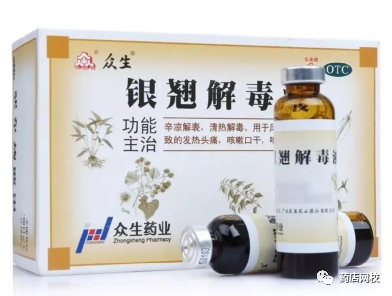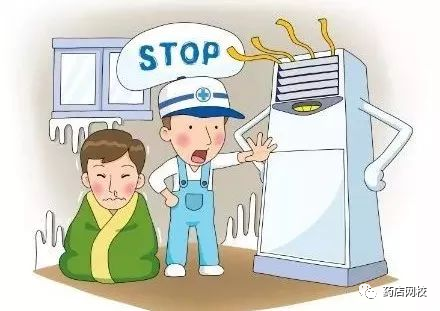Every time the seasons change, with the variation in weather, colds also enter a high incidence period. So, when facing customers with colds, how should we recommend medications as staff? Let’s take a look at the classification of colds and the corresponding suitable medications!01 Classification of ColdsWestern medicine classifies colds into common colds and influenza, while Traditional Chinese Medicine (TCM) classifies colds into Wind-Heat (Feng Re) colds, Wind-Cold (Feng Han) colds, Summer-Damp (Shu Shi) colds, and Wind-Dry (Feng Zao) colds.02 Symptoms and Medications for Different Colds1. Symptoms and Medications for Wind-Heat Colds Wind-Heat Cold:It is caused by the invasion of Wind-Heat evil and disharmony of Lung Qi. It often occurs in spring and summer, with symptoms summarized as nasal congestion, thick phlegm, and thirst. Specific symptoms include high fever, slight chills, nasal obstruction, thick yellow nasal discharge, thirst with a preference for drinking, yellow urine, red throat, and dryness. Patients can chooseYin Qiao Jie Du Liquid (Yin Qiao), Amoxicillin, Yin Huang Di Wan, and Chuan Xin Lian Nei Zhi Soft Capsulesamong others. The formula Yin Qiao Jie Du Liquid is classic, with guaranteed efficacy, volatile components, and quick effect, recommended in multiple guidelines such as the “Guidelines for TCM Treatment of Common Colds”.
Wind-Heat Cold:It is caused by the invasion of Wind-Heat evil and disharmony of Lung Qi. It often occurs in spring and summer, with symptoms summarized as nasal congestion, thick phlegm, and thirst. Specific symptoms include high fever, slight chills, nasal obstruction, thick yellow nasal discharge, thirst with a preference for drinking, yellow urine, red throat, and dryness. Patients can chooseYin Qiao Jie Du Liquid (Yin Qiao), Amoxicillin, Yin Huang Di Wan, and Chuan Xin Lian Nei Zhi Soft Capsulesamong others. The formula Yin Qiao Jie Du Liquid is classic, with guaranteed efficacy, volatile components, and quick effect, recommended in multiple guidelines such as the “Guidelines for TCM Treatment of Common Colds”. Combined Medications for Wind-Heat Colds
Combined Medications for Wind-Heat Colds
| Type | Symptoms | Combined Medications | Advantages |
| Wind-Heat Cold | High fever, sore throat, sore limbs, dry mouth, cough with thick yellow phlegm | Zhong Sheng Wan + Yin Qiao Jie Du Liquid + Amoxicillin Capsules + Vitamin C | Zhong Sheng Wan clears heat and detoxifies, invigorates blood and cools blood, relieves inflammation and pain; Yin Qiao Jie Du Liquid disperses Wind and clears heat, treating fever and headache caused by colds, cough and dry mouth, sore throat; Amoxicillin relieves inflammation, and supplementing Vitamin C can shorten the duration of the cold. |
2. Symptoms and Medications for Wind-Cold Colds Wind-Cold Cold:This cold is caused by exposure to cold wind, more common in autumn and winter. Symptoms include aversion to cold, fear of wind, no sweating, clear nasal discharge, thin white phlegm, and cough. Patients can choose Gan Mao Qing Re Capsules, Gan Mao Shu Feng Tablets, and Wind-Cold Cold Granules.Combined Medications for Wind-Cold Colds
Wind-Cold Cold:This cold is caused by exposure to cold wind, more common in autumn and winter. Symptoms include aversion to cold, fear of wind, no sweating, clear nasal discharge, thin white phlegm, and cough. Patients can choose Gan Mao Qing Re Capsules, Gan Mao Shu Feng Tablets, and Wind-Cold Cold Granules.Combined Medications for Wind-Cold Colds
| Type | Symptoms | Combined Medications | Advantages |
| Wind-Cold Cold | Severe chills, clear nasal discharge, heavy nasal congestion, cough with thin white phlegm | Gan Mao Qing Re Capsules + Compound Pseudoephedrine Sustained Release Capsules + Protein Powder | Gan Mao Qing Re Capsules disperse Wind and dispel Cold, treating clear nasal discharge; Compound Pseudoephedrine Sustained Release Capsules relieve nasal congestion; Protein Powder supplements protein to enhance the body’s resistance. |
3. Symptoms and Medications for Wind-Dry Colds Wind-Dry Cold:This often occurs in autumn, caused by the invasion of Dry Evil. Symptoms include fever, dry cough, little or no phlegm, blood-streaked phlegm, dry mouth, dry eyes, dry nose, and thirst. Patients can choose Snow Pear Syrup, Chuan Bei Snow Pear Syrup, etc.Combined Medications for Wind-Dry Colds
Wind-Dry Cold:This often occurs in autumn, caused by the invasion of Dry Evil. Symptoms include fever, dry cough, little or no phlegm, blood-streaked phlegm, dry mouth, dry eyes, dry nose, and thirst. Patients can choose Snow Pear Syrup, Chuan Bei Snow Pear Syrup, etc.Combined Medications for Wind-Dry Colds
| Type | Symptoms | Combined Medications | Advantages |
| Wind-Dry Cold | Headache, dry throat, sore throat, cough, blood-streaked phlegm | Chuan Bei Snow Pear Syrup + Yang Yin Qing Fei Wan + Roxithromycin Capsules | Chuan Bei Snow Pear Syrup has the effect of moistening the lungs and stopping cough, generating fluids and soothing the throat; Yang Yin Qing Fei Wan treats dry throat and cough with little phlegm; Roxithromycin Capsules treat pharyngitis and tonsillitis. |
4. Symptoms and Medications for Summer-Damp Colds Summer-Damp Cold:This often occurs in summer, with main symptoms including aversion to cold, fever, headache, head heaviness, nausea, and vomiting. Treatment should focus on clearing heat, dispelling dampness, and relieving the exterior. Patients can choose Huo Xiang Zheng Qi Liquid, Yin Qiao Jie Du Wan, etc.Combined Medications for Summer-Damp Colds
Summer-Damp Cold:This often occurs in summer, with main symptoms including aversion to cold, fever, headache, head heaviness, nausea, and vomiting. Treatment should focus on clearing heat, dispelling dampness, and relieving the exterior. Patients can choose Huo Xiang Zheng Qi Liquid, Yin Qiao Jie Du Wan, etc.Combined Medications for Summer-Damp Colds
| Type | Symptoms | Combined Medications | Advantages |
| Summer-Damp Cold | Dizziness, nausea, aversion to cold, fever | Huo Xiang Qu Shu Soft Capsules + Qing Re Qu Shi Granules + Vitamin C | Huo Xiang Qu Shu Soft Capsules dispel summer heat and transform dampness, relieve the exterior and harmonize the middle; Qing Re Qu Shi Granules clear heat and dispel dampness, tonify Qi and generate fluids, and supplementing Vitamin C can shorten the duration of the cold. |
5. Symptoms and Medications for Influenza Colds Influenza Cold:This is an acute respiratory infectious disease caused by the influenza virus, characterized by strong infectivity and rapid transmission. Clinical manifestations typically include sudden high fever, body aches, significant fatigue, and mild respiratory symptoms, with serious complications and mortality. Patients can choose Yin Qiao Jie Du Liquid (Zhong Sheng), Lian Hua Qing Wen Capsules, Qing Wen Jie Du Tablets, among others, with Yin Qiao Jie Du Liquid being the recommended medication in the latest “Influenza Diagnosis and Treatment Plan” from 2018.Combined Medications for Influenza Colds
Influenza Cold:This is an acute respiratory infectious disease caused by the influenza virus, characterized by strong infectivity and rapid transmission. Clinical manifestations typically include sudden high fever, body aches, significant fatigue, and mild respiratory symptoms, with serious complications and mortality. Patients can choose Yin Qiao Jie Du Liquid (Zhong Sheng), Lian Hua Qing Wen Capsules, Qing Wen Jie Du Tablets, among others, with Yin Qiao Jie Du Liquid being the recommended medication in the latest “Influenza Diagnosis and Treatment Plan” from 2018.Combined Medications for Influenza Colds
| Type | Symptoms | Combined Medications | Advantages |
| Influenza Cold | Chills, fever, headache, body aches | Oseltamivir + Yin Qiao Jie Du Liquid + Transfer Factor Oral Liquid | Oseltamivir inhibits the spread of the influenza virus in the body; Yin Qiao Jie Du Liquid treats fever and headache; Transfer Factor Oral Liquid assists Oseltamivir in exerting its effects. |
03 Health MaintenanceAfter customers purchase medications, we can advise them on daily prevention methods for colds and dietary supplements, allowing them to feel our caring service.1. TCM Health Maintenance FormulaIngredients and Method: Dang Shen (Codonopsis) 10g, Huang Qi (Astragalus) 10g, Ling Zhi (Reishi) 6g, Gou Qi Zi (Goji Berries) 6g, Da Zao (Jujube) 15g, Lean Meat 100g, stew into soup.Efficacy: Enhances physical fitness and prevents colds.2. Home Health Maintenance1. Taking Vitamin C can shorten the duration of colds and alleviate symptoms such as cough and sneezing.Rest more to retain recovery strength and avoid complications.2. Pay attention to warmth and take hot baths.3. Eat light foods, reduce fats, meats, and dairy, and increase fresh fruits to lessen bodily stress.4. Drink more water to replenish important fluids lost during colds and help expel harmful impurities.5. Avoid smoking, as it interferes with the ciliary activity that fights infections.6. Gargling with salt water can relieve discomfort.7. Avoid crowded public places.8. Maintain moderate and regular outdoor exercise to enhance the body’s immunity.


Chapter 3 Health Foods Since July 2005, the health foods approved in our country are mainly divided into two categories: one is nutrient supplements that provide vitamins and minerals. The second is health foods with specific health functions, which are divided into 27 categories, including assisting in lowering blood lipids, assisting in lowering blood sugar, assisting in lowering blood pressure, antioxidant, assisting in improving memory, promoting lead excretion, soothing the throat, promoting lactation, weight loss, improving growth and development, improving nutritional anemia, regulating intestinal flora, promoting digestion, relieving constipation, providing auxiliary protection against gastric mucosal damage, alleviating visual fatigue, treating acne, removing chloasma, improving skin moisture, improving skin oil content, enhancing immunity, improving sleep, alleviating physical labor fatigue, increasing hypoxia tolerance, providing auxiliary protection against radiation damage, increasing bone density, and providing auxiliary protection against chemical liver damage. In June 2012, the National Food and Drug Administration released the “Adjustment Plan for the Scope of Health Food Functions” (draft for comments), proposing to cancel 4 of the existing 27 functions (improving growth and development, providing auxiliary protection against radiation damage, assisting in lowering blood pressure, improving skin oil content), merging 4 functions related to gastrointestinal function into one (relieving constipation, regulating intestinal flora, promoting digestion, and providing auxiliary protection against gastric mucosal damage merged into aiding gastrointestinal function), merging 3 functions related to improving facial skin metabolism into one (treating acne, removing chloasma, and improving skin moisture merged into aiding facial skin health), retaining the rest, and finally determining 18 functions. Nutrition refers to the total process of the human body digesting, absorbing, and utilizing nutrients from food to maintain growth, development, tissue renewal, and health. Nutrients refer to substances with nutritional functions, including water, carbohydrates, fats, proteins, vitamins, and minerals. According to the World Health Organization (WHO), health is a state of complete physical, mental, and social well-being, not merely the absence of disease or infirmity. There are 13 universally recognized health indicators: being energetic, cheerful, and full of vitality; normal height and weight; smooth and shiny hair; strong and light pink nails; a pink tongue; good appetite; normal body temperature, pulse, and respiratory rate; healthy skin; normal urination and defecation; resistance to disease; bright eyes and pink conjunctiva; healthy gums and oral mucosa. Sub-health refers to a state of health overdrawn, where the body experiences various discomforts, manifested as easy fatigue, decline in physical strength, adaptability, and resilience, but without any organic lesions detected. Section 1 Protein (Amino Acids) Protein is the material basis of life; without protein, there is no life. Therefore, it is closely related to life and various forms of life activities. Every cell in the body and all important components involve protein. Protein accounts for 16.3% of body mass, meaning an adult weighing 60 kg has about 9.8 kg of protein in their body. There are many types of proteins in the human body, with different properties and functions, but they are all composed of more than 20 amino acids in different proportions, continuously undergoing metabolism and renewal in the body. Amino acids are the basic units that make up proteins, formed by polypeptide chains through “dehydration condensation” that fold into a specific spatial structure. 1. Physiological Functions 1. Structural basis of the body: Protein is the material basis of all life, an important component of body cells, and the main raw material for tissue renewal and repair. 2. Repairing body tissues: The human body consists of hundreds of billions of cells, which can be said to be the smallest unit of life, constantly undergoing metabolism of aging, death, and rebirth. 3. Maintaining normal metabolism and transport of various substances in the body: Carrier proteins are crucial for maintaining normal life activities, transporting various substances within the body. 4. Raw materials for synthesizing immune cells and immune proteins: Used to synthesize white blood cells, lymphocytes, macrophages, antibodies (immunoglobulins), complement, interferon, etc. 5. Constituting neurotransmitters: Acetylcholine and serotonin are used to maintain normal functions of the nervous system, such as taste, vision, and memory. 6. Forming collagen, which accounts for 1/3 of body protein, generates connective tissue, and forms the body’s framework, such as bones, blood vessels, ligaments, etc., determining skin elasticity and protecting the brain (a large part of brain cells are collagen cells, forming the blood-brain barrier to protect the brain). 7. Providing energy for life activities. 2. Dangers of Protein Deficiency Protein deficiency in the human body often occurs simultaneously with energy deficiency, known as protein-energy malnutrition. Protein-energy malnutrition can be divided into two types: wasting-type malnutrition and edema-type malnutrition. The former results from long-term dietary deficiency of energy, protein, and other nutrients; the latter is mainly caused by a lack of protein in the diet, with most affected children falling between the two. Wasting-type malnutrition initially presents as no weight gain or even weight loss. In the early stages of malnutrition, it is not easy to detect wasting if only looking at the face without a full-body examination. Affected children often cry and are irritable, then become dull. Initially, their appetite is good, then it declines to the point of disappearance, often accompanied by vomiting and diarrhea as acute digestive disorders. Edema-type malnutrition is characterized by edema, which is symmetrical on both sides of the body, first seen in the lower limbs, especially prominent on the dorsum of the foot. Additionally, affected children often exhibit weakness and mental depression, dry and cold skin, dry and yellow hair that easily falls out, and slow nail growth. 3. Related Products Protein powder, whey protein powder, collagen powder, hydrolyzed protein tablets, amino acid oral liquid, etc. (not suitable for those with liver and kidney dysfunction, or nephritis patients). Section 2 Carbohydrates Carbohydrates are the most abundant and widely distributed class of important organic compounds in nature. They are mainly composed of carbon, hydrogen, and oxygen; glucose, sucrose, starch, and cellulose belong to carbohydrate compounds. 1. Physiological Functions 1. Providing and storing energy: Each gram of glucose produces 16.8 kJ of heat; glucose is the main energy source for the nervous system; brain activity relies on aerobic oxidation of sugar for heat, with 2/3 of blood sugar consumed by the brain; glycogen in muscles and liver, etc. 2. Participating in the composition of the body or forming important life substances: Glycolipids formed from sugars and fats are important components of cell membranes and nervous tissues; glycoproteins formed from sugars and proteins are components of antibodies, enzymes, hormones, nucleic acids, etc. 3. Participating in the metabolism of other nutrients: Antiketogenic effect—normal metabolism of fats in the body requires the participation of carbohydrates; insufficient carbohydrates lead to incomplete fat oxidation, producing excessive ketone bodies (acetone, acetoacetate, etc.), resulting in ketosis; adequate carbohydrates have an antiketogenic effect. 4. Saving and protecting proteins: Insufficient carbohydrates in the diet force the body to utilize proteins to meet energy needs, affecting the body’s ability to synthesize new proteins and renew tissues. Therefore, the minimum carbohydrate intake for weight loss or diabetic patients should not be less than 150 g of staple food. 5. Participating in the liver’s detoxification function: Sufficient liver glycogen enhances the liver’s detoxification of certain harmful substances such as bacterial toxins; when glycogen is insufficient, the body’s detoxification of harmful substances like alcohol and arsenic is weakened, with glucuronic acid directly participating in liver detoxification. 6. Maintaining normal function of brain cells: Glucose is an essential nutrient for maintaining normal brain function; when blood sugar levels drop, brain tissue may suffer from energy deficiency, impairing brain cell function, leading to dysfunction, and causing dizziness, palpitations, cold sweats, and even coma. 2. Relationship Between Sugar Intake and Diseases 1. Excessive intake of monosaccharides and sucrose can easily induce dental caries, cardiovascular diseases, and diabetes. 2. Lactose intolerance. 3. Food Sources 1. Starch polysaccharides: Mainly found in plant-based foods. 2. Vegetables and fruits contain certain monosaccharides, disaccharides, as well as cellulose and pectin. Section 3 Unsaturated Fatty Acids Unsaturated fatty acids are a type of fatty acid that constitutes fats in the body and are essential fatty acids. In dietary fats, monounsaturated fatty acids include oleic acid, while polyunsaturated fatty acids include linoleic acid, alpha-linolenic acid, and arachidonic acid. The body cannot synthesize linoleic acid and alpha-linolenic acid, which must be supplemented through diet. 1. Physiological Functions 1. Maintaining the relative fluidity of cell membranes to ensure normal physiological functions of cells. 2. Esterifying cholesterol, lowering blood cholesterol and triglycerides, reducing blood viscosity, and improving microcirculation. Regulating blood lipids, lowering blood pressure, and preventing cardiovascular diseases. 3. Enhancing brain cell activity, improving memory, preventing age-related forgetfulness, and enhancing memory and thinking abilities in adolescents. 2. Symptoms Caused by Insufficient Unsaturated Fatty Acids in Diet 1. Increased low-density lipoprotein and low-density cholesterol in the blood, leading to atherosclerosis and inducing cardiovascular diseases. 2. Omega-3 unsaturated fatty acids are important nutrients for the brain and brain nerves; insufficient intake will affect memory and thinking ability, impacting intellectual development in infants and causing dementia in the elderly. Excessive intake in the diet can interfere with the synthesis of growth factors, cytoplasm, and lipoproteins, especially excessive omega-6 series unsaturated fatty acids will interfere with the utilization of omega-3 unsaturated fatty acids, easily inducing tumors. 3. Related Products Deep-sea fish oil soft capsules, wheat germ oil nutritional soft capsules (this product cannot replace medication. Not suitable for children, pregnant women, and those with bleeding disorders or tendencies). Section 4 Minerals Minerals (also known as inorganic salts) are the totality of inorganic substances in the human body, natural compounds or elements that exist in the earth’s crust. Like vitamins, minerals are essential elements for the human body, which cannot be produced or synthesized by itself. The daily intake of minerals is also basically determined, but varies with age, gender, physical condition, environment, and work conditions. Essential minerals for the human body include calcium, phosphorus, potassium, sodium, and chlorine, which are required in larger amounts, and iron, zinc, copper, manganese, cobalt, molybdenum, selenium, iodine, chromium, etc., which are required in smaller amounts. However, regardless of the element, they are in very small quantities compared to the protein required by the human body. 1. Calcium The calcium element in the human body mainly exists in the form of hydroxyapatite crystals in bones and teeth. Minerals in our body account for about 5% of body weight, with calcium accounting for about 2% of body weight. Most of the calcium in the body is distributed in bones and teeth, accounting for about 99% of the total amount, with the remaining 1% distributed in blood, interstitial fluid, and soft tissues. (1) Physiological Functions 1. 99% of calcium is used to maintain the health of bones and teeth. 2. 1% of calcium is distributed in blood, interstitial fluid, and soft tissues. Maintaining the concentration of blood calcium is crucial for normal life activities. 3. Calcium deficiency reduces the elasticity and toughness of soft tissues. Lack of elasticity in the skin can make it appear saggy and aged; lack of elasticity in the eye lens can lead to myopia and presbyopia; lack of elasticity in blood vessels can lead to hardening. 4. Reducing the excitability of nerve cells, making calcium a natural sedative. Calcium deficiency can lead to neurogenic migraines (10%-20% in women), restlessness, insomnia, and in infants, it can cause night terrors, night crying, and night sweats. Additionally, calcium deficiency can induce hyperactivity in children. 5. Strengthening the conduction function of the nervous system, aiding in the production and release of neurotransmitters. 6. Regulating (lowering) the permeability of cells and capillaries. Calcium deficiency can easily lead to allergies, edema, etc. 7. Promoting the activity of various enzymes in the body; when calcium is deficient, the secretion of gland cells is weakened. (2) Consequences of Calcium Deficiency Modern medical research has proven that calcium deficiency can cause physiological disorders in the human body, leading to a series of serious diseases. Here are some major diseases related to calcium deficiency. 1. Hypertension: Calcium deficiency can cause abnormal calcium influx, leading to abnormal accumulation of calcium in the cells of blood vessel walls and smooth muscle cells, causing blood vessel contraction, increased peripheral vascular resistance, and abnormal elevation of blood pressure. 2. Coronary heart disease: Calcium can also lower blood cholesterol levels, thus protecting the heart. High-calcium foods can reduce total cholesterol by 6%, with low-density lipoprotein decreasing by 11%, while the beneficial high-density lipoprotein remains unchanged. Scholars believe that long-term severe calcium deficiency can lead to coronary heart disease. 3. Osteoporosis: Long-term calcium deficiency in the human body leading to negative calcium balance is another serious consequence of osteoporosis. Many studies have shown that increasing calcium intake has a significant slowing effect on bone loss and is also important in reducing the fracture rate caused by osteoporosis, especially when taken with vitamin D, the effect is particularly significant. Calcium supplementation should start during puberty when bone mass is being formed for better results. (3) Related Products Liquid calcium soft capsules, calcium chewable tablets, collagen calcium, oyster calcium, etc. 2. Iron Iron is an essential trace element in the human body, with a total amount of 4-5 g, being an important part of hemoglobin, needed throughout the body. This mineral is present in red blood cells that supply oxygen to muscles. Additionally, it is a component of many enzymes and immune system compounds. (1) Physiological Functions 1. Iron is one of the components of hemoglobin and myoglobin, significantly influencing oxygen transport, transfer, and storage, and energy metabolism, preventing iron deficiency anemia caused by insufficient hematopoietic function. 2. Iron catalyzes and promotes the conversion of beta-carotene to vitamin A, the synthesis of purines and collagen, the production of antibodies, the transport of lipids from the blood, and the detoxification of drugs in the liver. 3. Iron is closely related to immunity; it can enhance the body’s immunity, increase the phagocytic function of neutrophils and macrophages, and improve the body’s ability to resist infections. (2) Iron Deficiency 1. Iron deficiency anemia: Insufficient oxygen supply to cells leads to fatigue and lethargy, significantly reducing work capacity, making the body more susceptible to infections. In severe cases, it can increase morbidity in children and mothers. 2. Behavioral and cognitive aspects: Iron deficiency can cause damage to psychological activities and cognitive development, as well as behavioral changes. Iron deficiency (even before anemia appears) can impair cognitive abilities in children, and it is difficult to recover even after iron supplementation later. 3. Temperature regulation: Another characteristic of iron deficiency anemia is impaired ability to maintain body temperature in cold environments. 4. Lead poisoning: Animal and human experiments have shown that iron deficiency increases lead absorption. 5. The impact of iron deficiency on the immune system: The ability to resist pathogenic microorganisms is weakened. (3) Related Products Iron folate tablets, heme iron supplements, etc. 3. Zinc Zinc is an essential element in the human body, playing an important role. An adult has about 2-2.5 g of zinc in their body, with the highest concentrations found in the eyes, hair, bones, and male reproductive organs; moderate amounts in the kidneys, liver, and muscles. In the blood, 75%-85% of zinc is in red blood cells, 3%-5% in white blood cells, and the rest in plasma. (1) Physiological Functions 1. A component of over 100 enzymes in the body: These enzymes play important roles in tissue respiration and the metabolism of proteins, fats, sugars, and nucleic acids. 2. Participating in the composition of salivary proteins: Zinc deficiency can lead to dull taste and reduced appetite. 3. Promoting normal development of reproductive organs and maintaining normal sexual function: Zinc deficiency can lead to delayed sexual maturation, underdevelopment of reproductive organs, reduced sexual function, and decreased sperm count, as well as irregular menstruation. 4. Protecting skin health: Zinc deficiency can lead to rough, dry skin, epithelial keratinization, and slow wound healing, making the skin more susceptible to infections. 5. Maintaining immune function: Due to zinc’s role in DNA synthesis, zinc deficiency leads to reduced proliferation of immune cells and decreased thymic activity. Due to zinc’s role in antioxidant biochemical enzymes, zinc deficiency alters cell surface receptors. 6. Other functions: Zinc helps clear cholesterol from the body, preventing and treating atherosclerosis; zinc also helps inhibit cancer occurrence, etc. (2) Zinc Deficiency When children experience chronic zinc deficiency, the main manifestation is growth stagnation. In adolescents, in addition to growth stagnation, there are also delayed sexual maturation, underdevelopment of reproductive organs, and underdevelopment of secondary sexual characteristics. If zinc deficiency occurs in pregnant women, it can affect fetal growth and development to varying degrees, leading to various deformities. Both children and adults with zinc deficiency can experience reduced taste and appetite, leading to pica. Common signs of human zinc deficiency include slow growth, poor wound healing, taste disorders, gastrointestinal diseases, and reduced immune function; thus, zinc supplementation is very important. (3) Related Products Zinc gluconate, licorice zinc preparations, etc. 4. Phosphorus Phosphorus is widely present in the human body, with a relatively high content, slightly less than calcium. It accounts for about 1% of total body weight, with adults containing 600-900 g of phosphorus. About 85.7% of phosphorus is concentrated in bones and teeth, with the rest distributed throughout various tissues and body fluids, with half present in muscle tissue. It not only constitutes body components but also participates in very important metabolic processes in life, making it a crucial element for the body. (1) Physiological Functions 1. An important raw material for building bones and teeth. 2. Phosphate constitutes important substances for life, promoting growth and repair of body tissues and organs. 3. Participating in metabolic processes, assisting in the metabolism of fats and starches, providing energy and vitality. 4. Participating in the regulation of acid-base balance in the body. 5. Patients with hyperthyroidism need to supplement phosphorus. (2) Phosphorus Deficiency 1. Phosphorus deficiency can lead to rickets and purulent gingivitis, among other diseases. 2. Phosphorus deficiency can cause weakness, fatigue, muscle soreness, and loss of appetite. (3) Related Products Soy lecithin soft capsules, soybean phospholipid soft capsules, fish oil phospholipid soft capsules, etc. Section 5 Vitamins 1. Vitamin A Vitamin A refers to all biologically active derivatives of beta-carotene, also known as retinol. Its best sources are various animal livers, fish liver oil, fish roe, whole milk, cream, and poultry eggs. Additionally, plants also contain provitamin A, such as beta-carotene. The measurement unit for vitamin A is the International Unit (IU). In 1965, the World Health Organization recommended discontinuing the use of international units and directly using retinol. 1 IU of vitamin A = 0.3 μg of retinol. (1) Physiological Functions 1. Maintaining vision: Vitamin A promotes the formation of photopigments in visual cells, adjusting the eye’s ability to adapt to varying light intensities, reducing the occurrence of night blindness and vision impairment, and maintaining normal visual responses, effectively preventing night blindness and dry eye diseases (such as treating dry eyes and conjunctivitis). 2. Promoting growth and development: Related to retinol’s regulation of genes, retinol also has steroid hormone-like effects, promoting the synthesis of glycoproteins. It promotes growth and development, strengthens bones, and maintains the health of hair, teeth, and gums. 3. Maintaining the integrity and health of epithelial structures: Vitamin A regulates the growth of epithelial tissue cells, maintaining the normal morphology and function of epithelial tissues; keeping the skin moist, preventing dryness and keratinization of skin mucosa, making it less susceptible to bacterial damage, aiding in the treatment of acne, pustules, and ulcers on the skin surface, and helping to remove age spots; it helps maintain the health of the surface of tissues or organs. 4. Enhancing immune capacity: Vitamin A helps maintain normal immune system function, strengthening resistance to infectious diseases, especially respiratory infections and parasitic infections; it also aids in the treatment of emphysema and hyperthyroidism. Vitamin A has certain antioxidant effects, neutralizing harmful free radicals. (2) Vitamin A Deficiency Disease Vitamin A deficiency disease is a nutritional disorder caused by a lack of vitamin A in the body. In children, vitamin A deficiency first manifests as night blindness, followed by keratinization of the entire epithelial tissue and secondary infections. Causes include insufficient intake, poor absorption, excessive consumption, and metabolic obstruction (this disease is more common in infants and young children). Clinical manifestations include: 1. Decreased dark adaptation ability, night blindness, dry conjunctiva and dry eye syndrome, appearance of eye spots, softening and perforation of the cornea leading to blindness. 2. Changes in mucous membranes and epithelium. 3. Growth and development are hindered, making them prone to respiratory infections. 4. Diminished taste and smell, decreased appetite. 5. Dry, rough hair, keratinization of hair follicles, decreased memory, irritability, and insomnia. (3) Related Products Multivitamin tablets, beta-carotene soft capsules, cod liver oil soft capsules, etc. 2. Vitamin D Vitamin D is a steroid derivative with anti-rickets effects, also known as the anti-rickets vitamin. The most important members of the vitamin D family are vitamin D2 and vitamin D3. They have the following two characteristics: they exist in some natural foods; after exposure to ultraviolet light, cholesterol in the body can be converted into vitamin D. (1) Physiological Functions Vitamin D exerts its effects mainly by promoting calcium absorption, thereby regulating various physiological functions. Vitamin D has the following physiological functions: 1. Increasing the body’s absorption of calcium and phosphorus, saturating the levels of plasma calcium and phosphorus. 2. Promoting growth and calcification of bones, ensuring healthy teeth. 3. Increasing phosphorus absorption through the intestinal wall and enhancing phosphorus reabsorption through renal tubules. 4. Maintaining normal levels of citrates in the blood. 5. Preventing the loss of amino acids through the kidneys. (2) Vitamin D Deficiency Vitamin D deficiency can lead to rickets, tetany, osteomalacia, and osteoporosis. Some medications can also affect calcium absorption, such as phenobarbital, which increases the metabolism of vitamin D, accelerating the excretion of its inactive metabolites and reducing the storage of vitamin D in the body. Phenytoin affects calcium-binding proteins, inhibiting calcium absorption. Long-term use of antiepileptic drugs can lower serum 25-hydroxyvitamin D levels and lead to osteomalacia. Long-term use of certain sleeping pills in non-epileptic patients can also lead to osteoporosis. These patients should be supplemented with physiological amounts of vitamin D as early as possible. (3) Related Products Calcium plus D chewable tablets, calcium vitamin D soft capsules, etc. 3. Vitamin E Vitamin E is a fat-soluble vitamin, also known as tocopherol, and is one of the main antioxidants. (1) Physiological Functions 1. Promoting the secretion of pituitary gland hormones; promoting the generation and activity of sperm; increasing ovarian function, leading to an increase in follicles and enlargement of luteal cells, enhancing the effect of progesterone. Deficiency can damage reproductive organs, making fertilization difficult or causing habitual abortion. 2. Improving lipid metabolism; deficiency leads to increased plasma cholesterol (TC) and triglycerides (TG), forming atherosclerosis. 3. Sensitive to oxygen, easily oxidized, thus protecting other easily oxidized substances, such as unsaturated fatty acids, vitamin A, and ATP, etc. Reducing the generation of peroxidized lipids, protecting body cells from free radical damage, and fully exerting the specific physiological functions of the protected substances. 4. Stabilizing cell membranes and the lipid portion of cells, reducing the fragility of red blood cells, preventing hemolysis. Deficiency can lead to hemolytic anemia. 5. Anti-aging and beauty, can eliminate the deposition of lipofuscin in cells, improve normal cell function, slow down the aging process of tissue cells, keep skin elastic, and maintain body vitality. (2) Vitamin E Deficiency Can cause destruction of red blood cells, degeneration of skin and muscle, hemolytic anemia, reproductive dysfunction, etc. (3) Related Products Natural vitamin E soft capsules, wheat germ oil nutritional soft capsules, etc. 4. Vitamin B Vitamin B includes vitamin B1, vitamin B2, vitamin B6, vitamin B12, niacin, pantothenic acid, folic acid, etc. These B vitamins are essential substances for promoting metabolism in the body, converting sugars, fats, and proteins into heat. (1) Physiological Functions 1. The energy required by the body’s muscles and nerves is mainly provided by carbohydrates, which are most easily affected. Sufficient vitamin B allows nerve cells to have abundant energy, alleviating anxiety and tension, increasing tolerance to noise, etc.; conversely, it leads to a decline in the ability to cope with stress, even causing neuritis. 2. Closely related to the metabolism of sugars, proteins, and fats, maintaining and improving the health of epithelial tissues, such as the epithelial tissue of the eyes and the mucosal tissue of the digestive tract. Severe deficiency can lead to visual fatigue, corneal congestion, angular cheilitis, etc. When angular cheilitis occurs, doctors often ask patients to take vitamin B2. 3. Poor fat metabolism can lead to seborrheic dermatitis, acne, and supplementation of vitamin B can have good effects. 4. Deficiency of B vitamins can lead to gastrointestinal motility disorders, poor secretion of digestive juices, causing indigestion, constipation, halitosis, and foul-smelling stools. 5. Niacin forms coenzymes for dehydrogenases in the body, playing an important role in the metabolism of carbohydrates, proteins, and fats; severe deficiency leads to neurological, skin, and digestive tract diseases, known as pellagra, also called the three D’s, manifested as dermatitis, diarrhea, and dementia. 6. Helping body tissues utilize oxygen, promoting the oxygen supply to skin, nails, and hair tissues, and improving or eliminating dandruff. 7. Detoxifying alcohol and nicotine, alleviating headaches, migraines, and protecting the liver. 8. Vitamin B12 deficiency can lead to megaloblastic anemia and neurological disorders. (2) Vitamin B Deficiency 1. Loss of appetite, gastrointestinal diseases, dry hair, memory decline, and cramps (muscle spasms) may indicate a possible deficiency of vitamin B1. 2. Vitamin B2 deficiency can lead to inflammation and dysfunction of the mouth, lips, skin, and reproductive organs, known as vitamin B2 deficiency disease, also called riboflavin deficiency disease. 3. Lack of niacin can easily lead to oral inflammation, dermatitis, microvascular proliferation, and pellagra. 4. Vitamin B6 deficiency prevents ingested food from being fully broken down, leading to ineffective absorption of nutrients, while a large amount of incompletely digested food in the body can produce many toxins. (3) Related Products Compound B vitamin tablets, brewer’s yeast tablets, etc. 5. Vitamin C (1) Physiological Functions 1. The synthesis of collagen requires the participation of vitamin C; thus, vitamin C deficiency leads to abnormal collagen synthesis, resulting in cell connection disorders. 2. Preventing vitamin C deficiency disease (also known as scurvy): The strength of blood vessel walls is closely related to vitamin C. Microvessels are the smallest blood vessels, with walls that may be only one cell thick; their strength and elasticity are determined by collagen, which connects cells. 3. Preventing gum recession and bleeding. Healthy gums tightly surround each tooth. Gums are soft tissue, and when lacking protein, calcium, and vitamin C, they are prone to recession and bleeding. 4. Preventing atherosclerosis. It can promote the excretion of cholesterol, preventing cholesterol from depositing in the walls of arteries, and can even dissolve deposited atheromatous plaques. 5. Vitamin C is a powerful water-soluble antioxidant. It can protect other antioxidants, such as vitamin A, vitamin E, and unsaturated fatty acids, preventing free radical damage to the human body. 6. Treating anemia: It reduces trivalent iron, which is difficult to absorb and utilize, to divalent iron, promoting intestinal absorption of iron and increasing the liver’s utilization of iron, aiding in the treatment of iron deficiency anemia. 7. Protecting cells, detoxifying, and protecting the liver: Ensuring the integrity of cells and the normal metabolism during life activities is crucial. 8. Enhancing the body’s immunity: White blood cells contain abundant vitamin C; when the body is infected, vitamin C in white blood cells decreases sharply. Vitamin C can enhance the chemotaxis and deformability of neutrophils, improving their bactericidal ability. 9. Vitamin C can promote the dissolution of urate salts in the tissues of gout patients, reducing the uric acid content in the body and preventing kidney uric acid stones and other diseases. (2) Suitable Populations 1. Individuals with poor physical condition, low resistance, easy fatigue, and prone to colds particularly need to increase their vitamin C intake. 2. Those working in polluted environments: Individuals with high vitamin C levels in their bodies are almost immune to harmful elements like lead, cadmium, and chromium. 3. Smokers: Consuming foods rich in vitamin C helps improve cell resistance, maintain vascular elasticity, and eliminate nicotine from the body. 4. Those engaged in intense exercise and high-intensity labor: These individuals lose a large amount of vitamin C through sweating and should replenish it in a timely manner. 5. Patients with vitamin C deficiency disease: Caused by a lack of vitamin C in the diet, leading to poor connective tissue formation and increased fragility of capillary walls. 6. Individuals with facial pigmentation: Vitamin C has antioxidant effects, and supplementing vitamin C can inhibit the formation of pigmentation and promote its regression. 7. Long-term medication users: Taking aspirin, sleeping pills, antitumor drugs, tetracycline, calcium supplements, antihypertensive drugs, etc., can reduce vitamin C in the body and cause other adverse reactions, requiring timely supplementation of vitamin C. 8. Cataract patients: Vitamin C is a nutrient for the lens of the eye; insufficient intake of vitamin C is one of the factors leading to cataracts, and patients should supplement vitamin C. (3) Related Products Vitamin C lozenges, natural compound vitamin C chewable tablets, cherry extract, etc. Section 6 Dietary Fiber Dietary fiber is a type of plant-based component that cannot be digested and absorbed in the human small intestine but can be partially or completely fermented in the human large intestine, encompassing polysaccharides, oligosaccharides, lignin, and related plant substances. It can be divided into two basic types based on solubility in water: soluble fiber and insoluble fiber. Common foods rich in soluble fiber include barley, legumes, carrots, citrus fruits, flaxseeds, oats, and oat bran, which can slow digestion and the rapid excretion of cholesterol, helping to regulate immune system function and promote the excretion of toxic heavy metals from the body. 1. Physiological Functions 1. Preventing and treating constipation: Dietary fiber has a large volume, promoting intestinal peristalsis and reducing the time food stays in the intestines, with moisture that is not easily absorbed. Dietary fiber ferments in the large intestine, directly absorbing moisture from the fiber, softening stools, and producing a laxative effect. 2. Beneficial for weight loss: Generally, obesity is related to increased caloric intake or decreased physical activity. Increasing the dietary fiber content can reduce caloric intake, and dietary fiber can prevent the absorption of some sugars and lipids in the small intestine, ultimately leading to fat consumption and weight loss. 3. Preventing and treating hemorrhoids: Hemorrhoids occur due to constipation, causing prolonged blood stasis and accumulation. The laxative effect of dietary fiber can reduce pressure around the anus, promoting smooth blood flow, thus preventing and treating hemorrhoids. 4. Lowering blood lipids and preventing coronary heart disease: Some components of dietary fiber, such as pectin, can bind cholesterol, while lignin can bind bile acids, leading to their direct excretion from feces, thus consuming cholesterol in the body to replenish the cholesterol used in bile, thereby lowering cholesterol and preventing coronary heart disease. 5. Improving diabetes symptoms: Pectin in dietary fiber can extend the time food stays in the intestine, reducing the speed of glucose absorption, preventing rapid spikes in blood sugar after meals, which is beneficial for improving diabetes. 2. Suitable Populations 1. Individuals with irregular bowel movements and constipation. 2. Obese individuals needing to control weight. 3. Diabetic patients. 4. Individuals with pigmentation and dull facial complexion. 3. Related Products Dietary fiber tablets, etc. Section 7 Plant Extracts 1. Anthocyanins Anthocyanins are widely present in the tissues of purple sweet potatoes, grapes, blood oranges, red cabbage, blueberries, eggplant skin, cherries, red oranges, red raspberries, strawberries, mulberries, hawthorn skin, perilla, black (red) rice, and morning glories. Fundamentally, anthocyanins are powerful antioxidants that can protect the body from damage caused by harmful substances called free radicals. Anthocyanins can enhance vascular elasticity, improve the circulatory system, and increase skin smoothness; they help prevent various diseases related to free radicals; enhance the immune system’s ability to resist carcinogens; reduce the frequency of colds and shorten their duration; have anti-inflammatory effects, thus preventing inflammation, including arthritis and swelling; alleviate pollen allergies and other allergies; maintain the normal flexibility of blood cells, helping red blood cells pass through small capillaries. Therefore, they enhance overall blood circulation, benefiting various organs and systems in the body and enhancing cell vitality. Suitable for individuals needing antioxidants, anti-aging, women wanting to maintain skin whitening, moisturizing, and elasticity, urban white-collar workers who spend long hours on computers and mobile phones, and those with cardiovascular diseases. 2. Soy Isoflavones Soy isoflavones are a type of flavonoid compound mainly found in leguminous plants, formed as secondary metabolites during soybean growth. Due to their similar structure to estrogen, soy isoflavones are also known as phytoestrogens, capable of compensating for the deficiency of female estrogen secretion after the age of 30, improving skin moisture and elasticity, alleviating menopausal syndrome, and improving osteoporosis, allowing women to regain youthful charm. The estrogenic effects of soy isoflavones influence hormone secretion, metabolic biological activity, protein synthesis, and growth factor activity, making them natural cancer chemopreventive agents. Suitable populations: Adult women wanting to delay aging (with sagging, rough, dull skin, and increased pigmentation), and peri-menopausal women experiencing irregular menstruation, insomnia, and dry skin. Not suitable for children or pregnant women. 3. Allicin Allicin has various biological activities and is known as a natural broad-spectrum antibiotic, with antifungal and antibacterial properties, and has good anti-cancer and cancer-preventive effects, enhancing immunity. Clinically, it is used for fungal infections of the lungs and digestive tract, cryptococcal meningitis, and acute and chronic bacterial dysentery and enteritis. It also lowers blood cholesterol, triglycerides, and lipoproteins, improving cardiovascular health, lowering blood lipids, blood pressure, and preventing and treating atherosclerosis and other cardiovascular diseases. Suitable for individuals with low immunity; middle-aged and elderly individuals with hypertension, hyperlipidemia, and coronary heart disease; those needing to resist viruses and eliminate blood and intestinal toxins. Not suitable for children. 4. Spirulina Spirulina, also known as blue-green algae, is a spiral-shaped algal plant with extremely high nutritional value and good health effects as a functional food. Spirulina is rich in gamma-linolenic acid, beta-carotene (10 times that of carrots), phycocyanin, and polysaccharides, which have good auxiliary effects in treating diseases. Spirulina is an alkaline food (pH 7-9), and many stomach diseases are caused by excessive stomach acid; it can effectively neutralize stomach acid and improve gastritis and gastric ulcers; it is rich in vitamin B1, B2, B3, pantothenic acid, and zinc, promoting the synthesis and secretion of insulin, making it a nemesis for diabetes; it contains over 60% high-quality protein and various vitamins and minerals that can assist in improving liver diseases; 1 g of spirulina has the nutritional value equivalent to 1 kg of various vegetables. Suitable populations: Children and adolescents in growth and development; elderly and weak individuals with insufficient nutrient absorption; dieters; those with unreasonable dietary combinations; individuals with anemia or calcium deficiency due to unbalanced nutrient absorption; and those recovering from illness. Related products: Grape seed soft capsules, soy isoflavone capsules, allicin soft capsules, garlic treasure soft capsules, spirulina nutritional tablets, etc.
>> The above information is sourced from the internet, organized by the Pharmacy Education Network, and is for reference by professionals only.

Every night at 7:40, we broadcast on time , exciting learning content!
, exciting learning content!
❤❤ Click the 【Read Original below to watch more content

